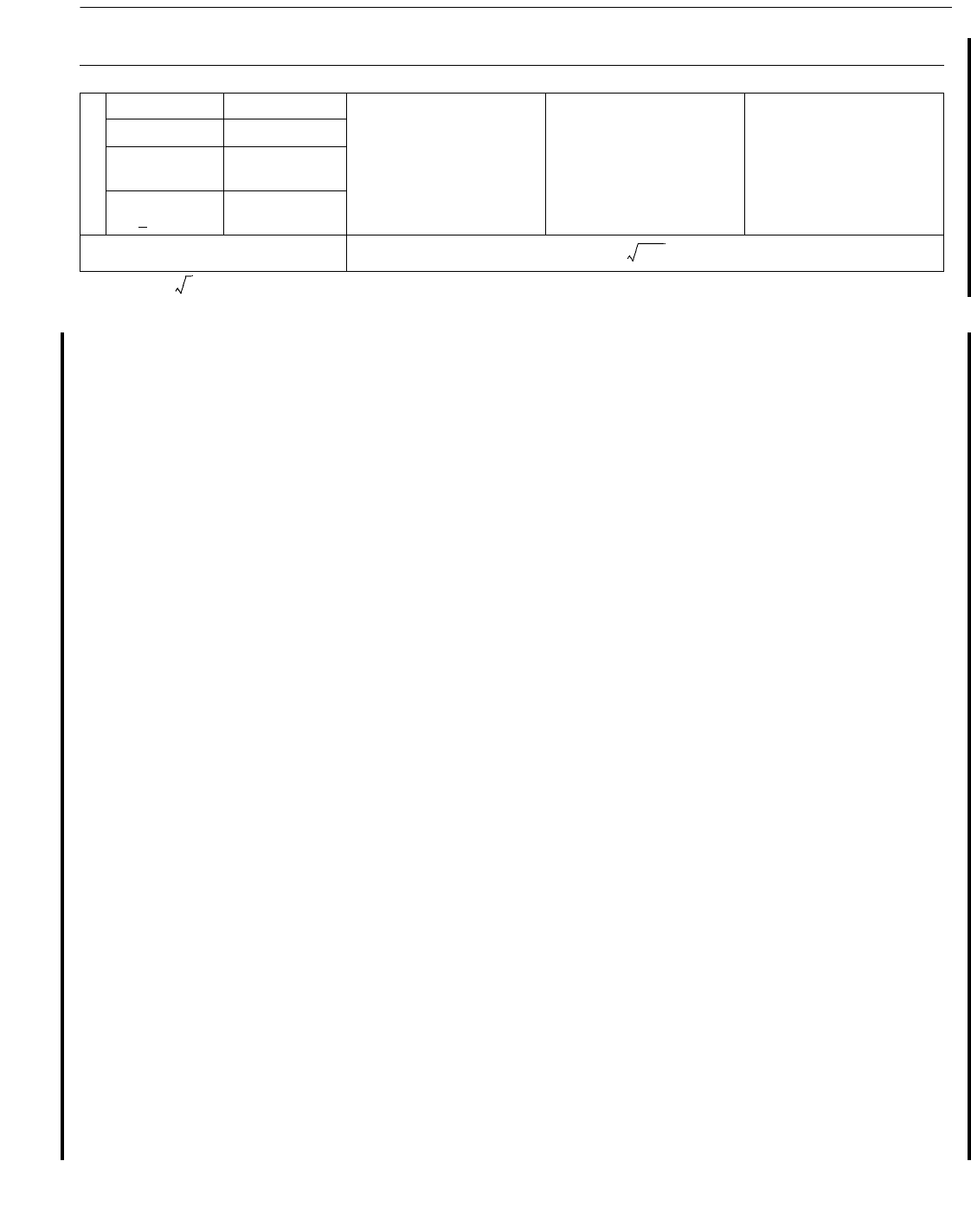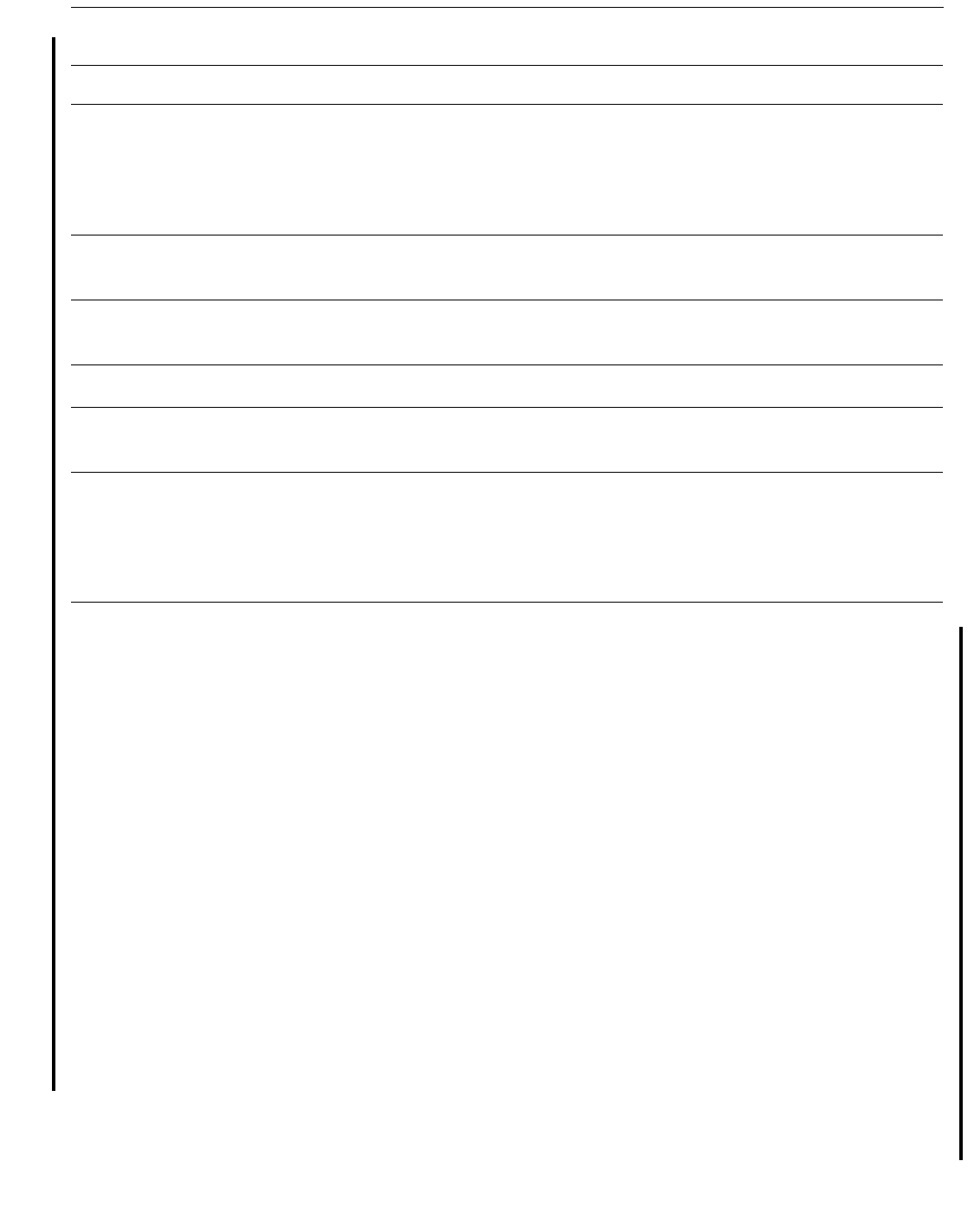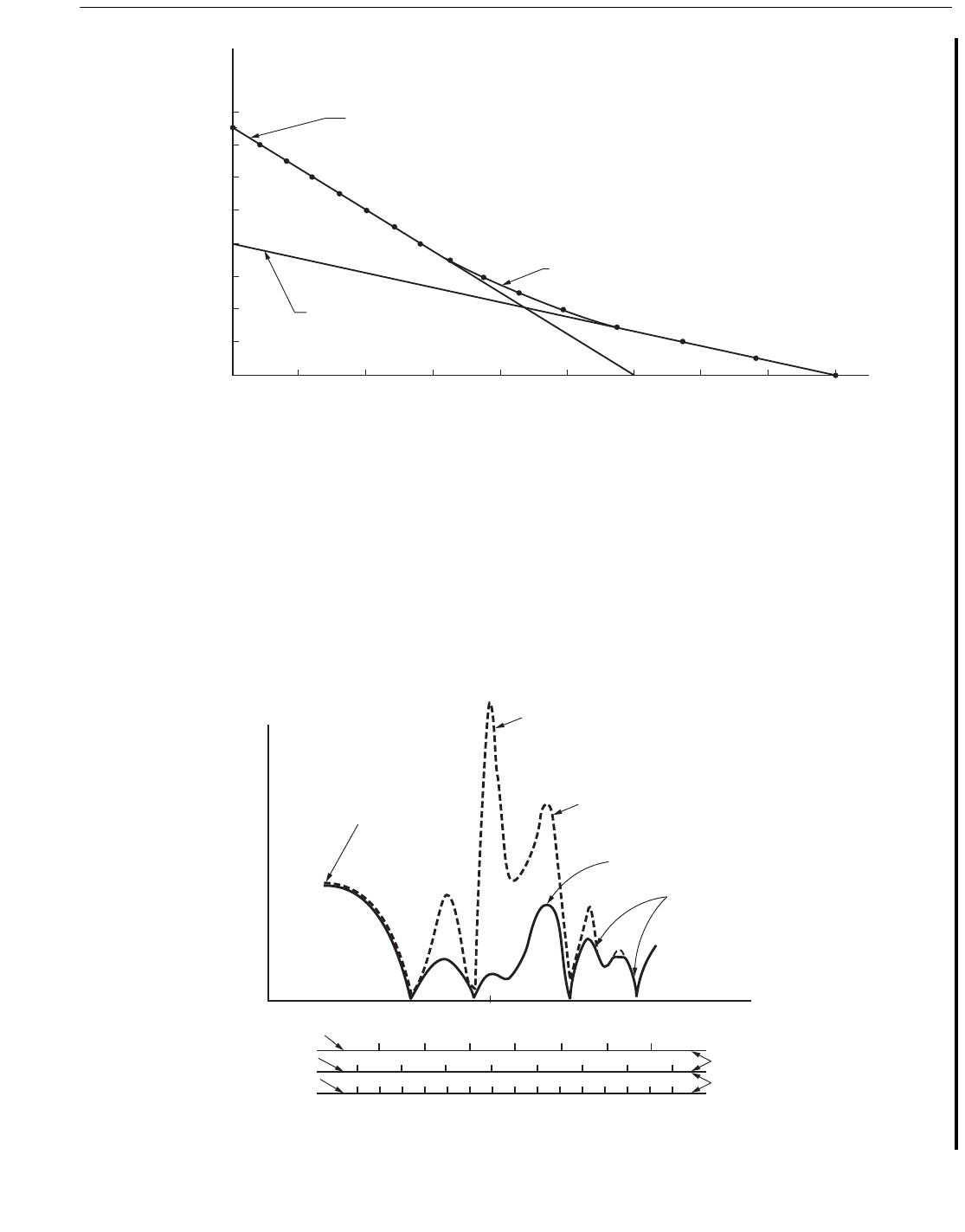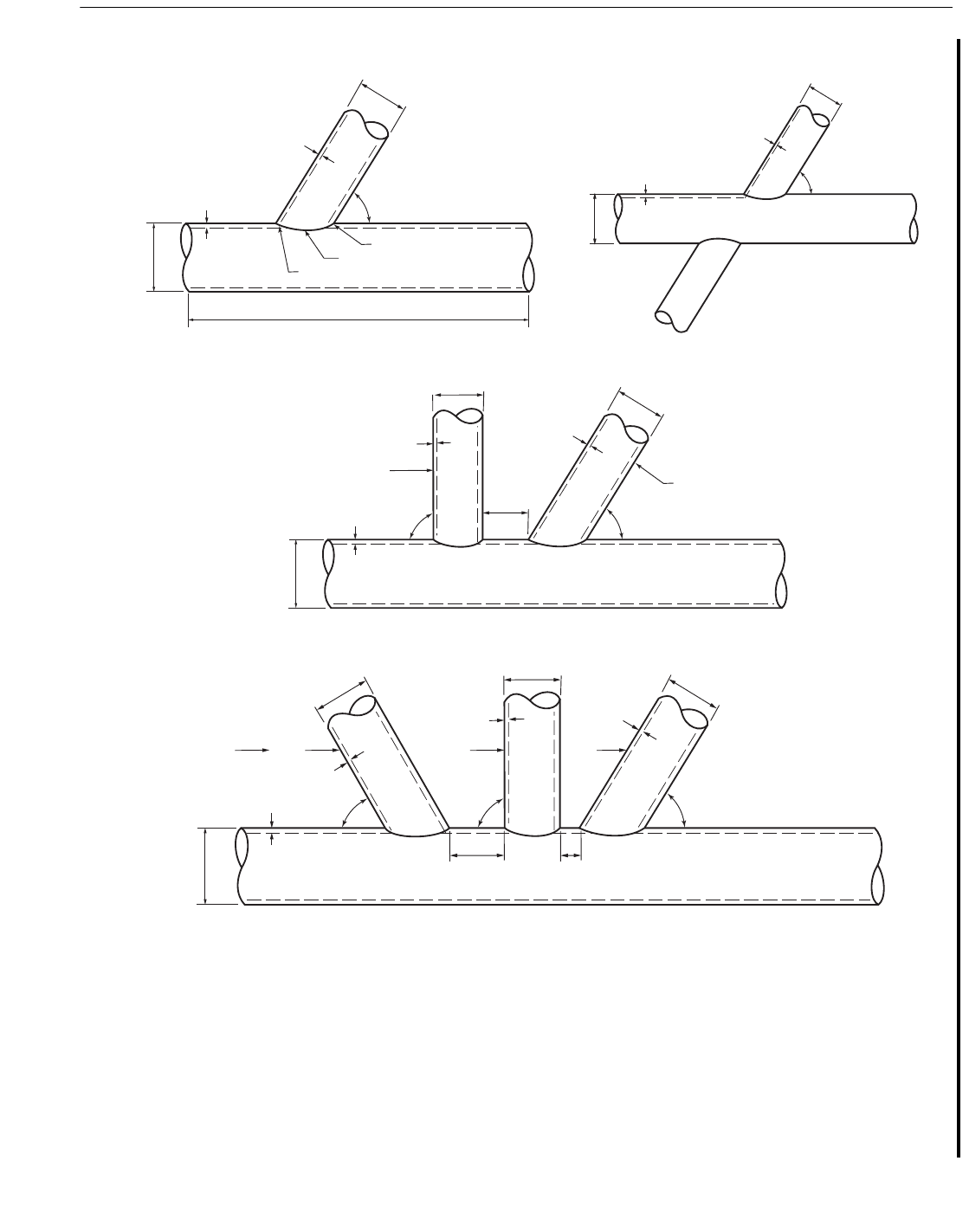API RP 2A-WSD-2007 Recommended Practice for Planning, Designing and Constructing Fixed Offshore Platforms-Working Stress Design
Подождите немного. Документ загружается.


RECOMMENDED PRACTICE FOR PLANNING, DESIGNING AND CONSTRUCTING FIXED OFFSHORE PLATFORMS—WORKING STRESS DESIGN 199
where:
N
t
= total cycles in reference time period,
S
rmax
= the maximum (design) stress range in the refer-
ence time period (e.g., 100 yr),
K = N
o
S
o
m
,
N
o
= reference cycles at knee of S-N curve,
S
o
= reference stress at knee of S-N curve,
m = log-log inverse slope of S-N curve, and
D = damage ratio for reference period (e.g., 5/SF for
20-year service life).
Solution of the equation is facilitated by plots of G(ξ),
log(10) of the right-hand part of the expression, which can be
found in Refs. 20 & 25.
Closed form calculations were performed, and the result-
ing allowable design stress ranges for proposed S-N curves
for both profiled and non-profiled joints were determined.
Results for the new profiled joint rules follow those for old
curve X, even more closely than the S-N curves themselves,
which crisscross each other. This is because we are now inte-
grating fatigue damage along the curve, rather than just look-
ing at one point. The results are so close in the range of ξ =
0.5 to ξ = 0.8, that the API simplified design curves for the
Gulf of Mexico remain valid. Results for new curve WJ for
non-profiled welds correspond to those for old curve X-
prime, and closely follow traditional DoE/HSE practice.
Some additional conservatism in the new fatigue rules will
come from the adoption of Efthymiou’s SCF, instead of the
old Alpha Kellogg method. Reference 43 presented a com-
parison of the two and defense of the latter, to coincide with
the 1993 fatigue changes in RP 2A-WSD. To maintain con-
sistency with previous successful practice, Alpha Kellogg
may be used for preliminary design, with a safety factor of
2.0 on life.
Design comparisons of joint can thickness (when governed
by fatigue) have also been carried out for previous API, new
RP 2A-WSD 21
st
edition supplement, and proposed ISO CD
19902 fatigue criteria (S-N knee at 10
8
cycles). The design
comparisons are more comprehensive than just looking at the
S-N curves. They include consideration of different long-term
stress distributions (by region and water depth), new SCF for-
mulae, weld toe corrections, profiling practices, and size
effects for thicknesses typical of regional design practices.
Results are shown in Table C5.1-2. The new API (including
Efthymiou SCFs and reduced safety factor) is more-or-less
consistent with existing API practice. In view of the good track
record of API fatigue criteria to date, this brute force calibra-
tion is considered satisfactory justification of the new criteria.
C5.2 FATIGUE ANALYSIS
A simplified fatigue analysis may be used as a first step for
structures in deep water or frontier areas. However, a detailed
analysis of cumulative fatigue damage should always be per-
formed. A detailed analysis is necessary to design fatigue
sensitive locations that may not follow the assumptions inher-
ent in the simplified analysis.
C.5.2.1 Wave climate information is required for any
fatigue analysis, and obtaining it often requires a major effort
with significant lead time. Wave climates may be derived
from both recorded data and hindcasts. Sufficient data should
exist to characterize the long term oceanographic conditions
at the platform site. Several formats are permissible and the
choice depends on compatibility with the analytical proce-
dures being used. However, for each format the wave climate
is defined by a series of sea states, each characterized by its
wave energy spectrum and physical parameters together with
a probability of occurrence (percent of time). Formats that
may be used include the following:
1. Two Parameter scatter diagrams. These describe the
joint probability of various combinations of significant
wave height and mean zero crossing period. Typically,
60 to 150 sea states are used to describe most sea envi-
ronments. While a reduced number may be used for
analysis, a sufficient number of sea states should be
used to adequately define that scatter diagram and
develop full structural response. If the scatter diagram
Table C5.1-1—Selected SCF Formulas for Simple Joints
Joint Type α Axial Load In-Plane Bending Out-of-Plane Bending
Chord SCF
K 1.0
α A 2/3 A 3/2 A
T & Y 1.7
X
β < 0.98
2.4
X
β >
0.98
1.7
Brace SCF’s
1.0 + 0.375 (1 + SCF
chord
) ≥ 1.8
Where A = 1.8 τ sin θ and all other terms are defined in Figure 4.1-1.
05
τβ⁄
γ
05
05
Copyright American Petroleum Institute
Provided by IHS under license with API
Licensee=Indonesia location/5940240008
Not for Resale, 10/22/2008 00:07:12 MDT
--`,,```,,,`,,,,,,,,,,,,,,`,``,`-`-`,,`,,`,`,,`---

200 API RECOMMENDED PRACTICE 2A-WSD
is condensed the effect of dynamic excitation, interac-
tion between wave length and platform geometry, and
drag force non-linearity should be considered. When
condensing sea states of different height or period the
resulting sea states should yield equivalent or greater
damage than the original sea states. This format does
not give any information on wave directionality.
2. Directional scatter diagrams. Each sea state is char-
acterized by three parameters: significant wave height,
mean zero-crossing period and central direction of
wave approach (Ref. 3). If the measured data do not
include wave directionality, directions may be esti-
mated on the basis of wind measurements, local
topography, and hindcasting, provided sufficient care
is exercised.
3. Directional scatter diagrams with spreading. Each
sea state is characterized by four parameters: signifi-
cant wave height, mean zero-crossing period, central
direction of wave approach, and directional spreading.
The directional spreading function, D(θ), defines the
distribution of wave energy in a sea state with direction
and must satisfy:
(θ) dθ = 1 (C5.2-1)
Where θ is measured from the central direction. A
commonly used spreading function (Ref. 7) is:
D (θ) = C
n
cos
n
θ (C5.2-2)
Where n is a positive integer and C
n
is a coefficient
such that Eq. C5.2-1 is satisfied.
A value of n equal to zero corresponds to the case
when the energy is distributed in all directions. Obser-
vations of wind driven seas show that an appropriate
spreading function is a cosine square function (n = 2).
For situations where limited fetch restricts degree of
spread a value of n = 4 has been found to be appropri-
ate. Other methods for directional spreading are given
in Ref. 21.
4. Bimodal spectra. Up to eight parameters are used to
combine swell with locally generated waves. Typically,
swell is more unidirectional than wind generated
waves and thus spreading should not be considered
unless measured data shows otherwise (Ref. 22).
Table C5.1-2—Summary of Design Comparisons, Resulting Variation of Joint Can Thickness
20
th
-21
st
Ed. RP 2A-WSD
21
st
Edition
RP 2A-WSD Supplement
2001 ISO CD
19902
GULF OF MEXICO profiled
shallow water ξ =0.5
old = multiplanar Fig C4.3.1-2 1.6" 1.4" 1.6"
old = α Table C5.1-1 1.4" 1.5" 1.7"
deep water ξ =0.7
old = multiplanar Fig C4.3.1-2 3.0" 3.0" 3.8"
CALIFORNIA profiled
shallow water ξ =1.0 old = Fig C4.3.1-2 1.4" 1.3" 1.8"
deep water ξ =1.3 old = Fig C4.3.1-2 2.0" 1.9" 2.8"
NORTH SEA NOT profiled τ =0.33 γ =13.3
typical stiff ξ =1.0
existing = Efthymiou 3.0" 3.3" 3.7"
BORNEO, INDONESSIA NOT profiled
ξ =1.0 existing = Efthymiou 1.4" 1.5" 1.6"
WEST AFRICA NOT profiled
ξ =1.3 persistent swell
existing = Efthymiou 1.4" 1.3" 1.5"
All cases are for 45-degree K-joint with:
concentric WP
τ =0.5
γ =20
β=0.5
unless noted otherwise
05
D
π 2⁄–
π 2⁄
∫
05
Copyright American Petroleum Institute
Provided by IHS under license with API
Licensee=Indonesia location/5940240008
Not for Resale, 10/22/2008 00:07:12 MDT
No reproduction or networking permitted without license from IHS

RECOMMENDED PRACTICE FOR PLANNING, DESIGNING AND CONSTRUCTING FIXED OFFSHORE PLATFORMS—WORKING STRESS DESIGN 201
Figure C5.1-3—Example Wave Height Distribution Over Time T
Figure C5.2-1—Selection of Frequencies for Detailed Analyses
N, Number of Waves Exceeding H (Cycles per 100 Years)
1
10 100 10
3
10
4
10
5
10
6
10
7
10
8
10
9
10
20
30
40
50
60
70
80
0
H, Wave Height (ft)
Hurricane component
(H
1
= 75', H
1
= 1.0 x 10
6
, X
1
= 1.0)
Normal component
(H
0
= 40', N
0
= 1.0 x 10
9
, X
0
= 1.0)
Sum of normal + hurricane
components
where:
H
0
= the maximum normal wave height over period T,
H
1
= the maximum hurricane wave height over period T,
N
0
= the number of wave cycles from normal distribution over period T,
N
1
= the number of wave cycles from hurricane distribution over period T,
T = the duration of the long-term wave height distribution,
X
0
= the parameter defining the shape of the Weibull normal distribution. Value of 1.0
corresponding to the exponential distribution results in a straight line,
X
1
= the parameter defining the shape of the Weibull hurricane distribution.
05
Low frequency (long period
waves). No canceling effects,
deterministic analysis
adequate for this frequency
range (e.g., storm waves)
Resonance peak
Dynamic transfer
function
Static transfer
function
Peaks and valleys due to
interaction between wave
length and platform
geometry (i.e., cancellation
effects)
f
n
(platform natural frequency)
Wave Frequency
POOR: under-predicts response
Selected frequency
increments too large
Adequate number
of frequencies
POOR: over-predicts response
GOOD: adequately represents
transfer function
Copyright American Petroleum Institute
Provided by IHS under license with API
Licensee=Indonesia location/5940240008
Not for Resale, 10/22/2008 00:07:12 MDT
No reproduction or networking permitted without license from IHS

202 API RECOMMENDED PRACTICE 2A-WSD
Data gathered in more complete formats can always
be reduced to the simple ones. For recorded data and
hindcasting, spectral characterizations described by
Borgman and Cardone (Ref. 4 & 5), can serve as start-
ing points.
C.5.2.2 The space frame model for fatigue analysis should
include all important characteristics of the stiffness, mass,
energy dissipation, marine growth and loading properties of
the structure and foundation components of the platform. The
analytical model consists primarily of beam elements. The
adequacy of calculated member end stresses for fatigue anal-
ysis is contingent on the modeling techniques used. The
model used for strength analysis may require refinements
such as the additional or modification of members which are
fatigue sensitive. Asymmetry in platform stiffness or mass
distribution may lead to significant torsional response which
should be considered.
Stiffness
The model should include the three dimensional distribu-
tion of platform stiffness. The member intersections should
be modeled such that the resulting nominal member end
stresses are consistent with their subsequent use in fatigue
analysis. For typical jacket members, nominal brace stresses
should be computed at the intersections of the brace and
chord centerlines. For large diameter chords or short braces,
local joint stiffness should be considered. One modeling tech-
nique that has been used to represent the joint stiffness is to
simulate the chord stiffness between the intersection of the
centerlines and the chord face as a rigid link with springs at
the face representing the chord shell flexibility. Member end
stresses should then be calculated at the face of the chord.
Rigid links should not be used without also considering chord
shell flexibility.
The stiffness of appurtenances such as launch cradles, mud
mats, J-tubes, risers, skirt pile guides, etc., should be included
in the model if they contribute significantly to the overall glo-
bal stiffness of the structure. The stiffness of the conductors
and horizontal framing levels should be included. In addition,
down to and including the level immediately below the
design wave trough elevation, sufficient detail should be
included to perform a fatigue analysis of the individual com-
ponents of the framing. Similar detailing of the mudline level
is required if the conductors are considered in the foundation.
Consideration of structural components such as mud mats,
shear connectors, conductor guides, etc., may require finite
element types other than beam elements (e.g., shell, plate,
solid elements, etc.).
The stiffness of the deck should be considered in sufficient
detail to adequately represent the deck-jacket interface.
A linear representation of the foundation may be used pro-
vided the stiffness coefficients reflect the cyclic response for
those sea states contributing significantly to fatigue damage.
Mass
The mass model should include structural steel, equip-
ment, conductors, appurtenances, grout, marine growth,
entrapped water, and added mass. A lumped mass model is
sufficient to obtain global structure response. However, this
method may not adequately predict local dynamic response.
Where necessary, local responses should be examined. The
equipment mass included in the model should consider all
equipment supported by the structure during any given oper-
ation on the platform. If the equipment mass is produced to
vary significantly for different operations during the plat-
form life, it is appropriate to perform independent analyses
and combine fatigue damage. The added mass may be esti-
mated as the mass of the displaced water for motion trans-
verse to the longitudinal axis of the individual structural
framing and appurtenances.
Energy Dissipation
The choice of damping factors can have a profound effect,
and values of 2% critical and less have been suggested on the
basis of measurements in low sea states. Including structural
velocities in the calculation of drag forces increases the total
system damping. For non-compliant structures, this increase
in damping is not observed in measurements and conse-
quently should not be considered. For compliant structures
such as guyed towers, these effects may be considered in
addition to a 2% structural (including foundation) damping.
Natural Period
For structural natural periods above three seconds,
dynamic amplification is important, particularly for the lower
sea states which may contribute the most to long term fatigue
damage. Several authors have shown the desirability of
retaining the detailed information available from a full static
analysis and adding the inertial forces due to dynamic ampli-
fication of the first few modes (mode acceleration or static
back-substitution method, Ref. 24). A pure modal analysis
using a limited number of modes misses the essentially static
response of some modes.
Since the natural period of a platform can vary consider-
ably depending upon design assumptions and operational
deck mass, a theoretical period should be viewed critically if
it falls in a valley in the platform base shear transfer function.
The period should be shifted by as much as 5 to 10% to a
more conservative location with respect to the transfer func-
tion. This should be accomplished by adjusting mass or stiff-
ness within reasonable limits. The choice of which parameter
to modify is platform specific and depends upon deck mass,
soil conditions and structural configuration. It should be rec-
ognized that adjusting the foundation stiffness will alter the
member loads in the base of the structure which can be
fatigue.
05
05
Copyright American Petroleum Institute
Provided by IHS under license with API
Licensee=Indonesia location/5940240008
Not for Resale, 10/22/2008 00:07:12 MDT
No reproduction or networking permitted without license from IHS

RECOMMENDED PRACTICE FOR PLANNING, DESIGNING AND CONSTRUCTING FIXED OFFSHORE PLATFORMS—WORKING STRESS DESIGN 203
Loading
The applied cyclic loads should be represented such that
the effects of load distribution along the member are included
in the member end stresses. Distributed loads on brace mem-
bers need to be considered only between intersection points.
Loads attributed to conductors and appurtenances such as
launch cradles, mud mat framing, J-tubes, risers, skirt pile
guides, anodes, etc., should be considered. The choice of
wave theory as well as drag and mass coefficients should be
examined as they may differ from those used in strength anal-
yses for design wave loads. Attention should be given to mod-
eling of conductor guide framing to ensure accurate vertical
wave loads. When the loading varies significantly for differ-
ent operations during the platform life, (e.g., transportation,
drilling, and production), it is appropriate to perform separate
analyses and combine the fatigue damages from each.
Tides, currents and marine growth each affect fatigue. For
everyday waves, tides will have little effect. However, the
tide and surge associated with storm seas can have a signifi-
cant effect. For example, they may cause the wave crest to
inundate a member or entire jacket level, which would other-
wise be dry. Such effects should be considered.
Current is a complicated phenomenon that is difficult to
account for in a fatigue analysis. Since fatigue considers the
stress range, the static effect of current can be neglected. For
large waves or currents, the drag will increase the crest-to-
trough wave force difference and affect platform dynamics.
While these effects can be important, analysis technology is
lacking.
Marine growth may have a detrimental effect on fatigue
life of members due to the increase in local and global wave
loading. A marine growth profile should be specified for the
average thickness and roughness expected at the platform site
over the service life, if the inclusion of marine growth gives
conservative results. A simplified analysis is useful in study-
ing the effect of marine growth on global response. Marine
growth affects platform added mass, member drag diameter,
and drag coefficient.
Spectral Analysis Techniques
Several approaches are available for determining stress
response to sea state loadings. In general, a spectral analysis
should be used to properly account for the actual distribution
of wave energy over the entire frequency range. The spectral
approach can be subdivided based upon the method used to
develop transfer functions.
1. Transfer functions developed using regular waves in the
time domain.
– Characterize the wave climate using either the two,
three, four or eight parameter format.
– Select a sufficient number of frequencies to define all
the peaks and valleys inherent in the jacket response
transfer functions. A typical set of frequencies is illus-
trated in Figure C5.2-1. A simplified analysis (Ref. 7)
that develops a global base shear transfer function may
be helpful in defining frequencies to be used in the
detailed analysis.
– Select a wave height corresponding to each frequency.
A constant wave steepness that is appropriate for the
wave climate can be used. For the Gulf of Mexico a
steepness between 1:20 and 1:25 is generally used. A
minimum height of one foot and a maximum height
equal to the design wave height should be used.
– Compute a stress range transfer function at each point
where fatigue damage is to be accumulated for a mini-
mum of four platform directions (end-on, broadside
and two diagonal). For jackets with unusual geometry
or where wave directionality or spreading or current is
considered, more directions may be required. At each
frequency, a point on the transfer function is deter-
mined by passing an Airy wave of the appropriate
height through the structure and dividing the response
stress range by the wave height. The analysis procedure
must eliminate transient effects by achieving steady
state conditions. A sufficient number of time steps in
the wave cycle at which members stresses are com-
puted should be selected to determine the maximum
brace hot spot stress range. A minimum of four hot spot
locations at both the brace and chord side of the con-
nection should be considered.
– Compute the stress response spectra. In a spectral
fatigue analysis in its most general form, each sea state
is represented by a power spectral density function Sα
(ω) for each direction of wave approach α, where ω is
circular frequency. At each location of interest, the plat-
form stress response spectrum for each sea state is:
S
σ,α
(ω)= | H (ω, θ) |
2
D(θ)S
α
(ω) dθ (C5.2-3)
where θ is measured from the central wave
approach direction, H (ω, θ) is the transfer function and
D (θ) is the preading function as defined in Section
C5.2.1(3)
Several approximations and linearizations are intro-
duced into the fatigue analysis with this approach:
– The way in which waves of different frequencies in a
sea state are coupled by the non-linear drag force is
ignored.
– Assuming a constant wave steepness has the effect of
linearizing the drag force about the height selected for
each frequency. Consequently, drag forces due to
waves at that frequency with larger heights will be
under-predicted, while drag forces due to waves with
smaller heights will be over-predicted.
05
05
π 2⁄–
π 2⁄
∫
Copyright American Petroleum Institute
Provided by IHS under license with API
Licensee=Indonesia location/5940240008
Not for Resale, 10/22/2008 00:07:12 MDT
--`,,```,,,`,,,,,,,,,,,,,,`,``,`-`-`,,`,,`,`,,`---

204 API RECOMMENDED PRACTICE 2A-WSD
2. Transfer functions developed using regular waves in the
frequency domain. This approach is similar to method (1)
except that the analysis is linearized prior to the calculation of
structural response. In linearizing the applied wave force,
drag forces are approximated by sinusoidally varying forces
and inundation effects are approximated or neglected. As a
result, the equations of motion can then be solved without
performing direct time integration. For typical small waves
the effects of linearization are not of great importance; how-
ever, for large waves they may be significant if inundation
effects are neglected.
3. Transfer functions developed using random waves in the
time domain. (Ref. 23).
– Characterize the wave climate in terms of sea state scat-
ter diagrams.
– Simulate random wave time histories of finite length
for a few selected reference sea states.
– Compute response stress time histories at each point of
a structure where fatigue life is to be determined and
transform the response stress time histories into
response stress spectra.
– Generate “exact” transfer functions from wave and
response stress spectra.
– Calculate pseudo transfer functions for all the remain-
ing sea states in the scatter diagram using the few
“exact” transfer functions.
– Calculate pseudo response stress spectra as described
in Section (C5.2.2-1).
This method can take into account nonlinearities arising
from wave-structure interaction and avoids difficulties in
selecting wave heights and frequencies for transfer function
generation.
C.5.2.3 In evaluating local scale stresses at hot spot loca-
tions the stress concentration factors used should be consis-
tent with the corresponding S-N curve, reference Sections 5.4
and 5.5.
C.5.2.4 Various approaches to a Miner cumulative damage
summation have been used. In all cases, the effects from each
sea state are summed to yield the long term damage or predict
the fatigue life. Approaches include:
For a spectral analysis, the response stress spectrum may
be used to estimate the short-term stress range distribution for
each sea state by assuming either:
1. A narrow band Rayleigh distribution. For a Rayleigh dis-
tribution the damage may be calculated in closed form.
2. A broad band Rice distribution and neglecting the nega-
tive peaks.
3. Time series simulation and cycle counting via rainflow,
range pair, or some other algorithm.
Damage due to large waves that have significant drag
forces or crest elevations should be computed and included in
the total fatigue damage.
C.5.2.5 A calculated fatigue life should be viewed as
notional at best. Where possible, the entire procedure being
used should be calibrated against available failure/non-failure
experience. Although 97% of the available data falls on the
safe side of the recommended S-N curves, additional uncer-
tainties in wave action, seawater effects, and stress analysis
result in a 95% prediction interval for failures ranging from
roughly 0.5 to 20 times the calculated fatigue life at D of
unity (ref. 11), for the API criteria of 11
th
to 21
st
editions
(prior to this supplement), which anticipated the use of best-
estimate SCF. For the new criteria, using Efthymiou SCF, the
prediction interval becomes 0.85 to 50 times the calculated
fatigue life. Additional time is required for the progressive
failure of redundant structures. Calibration hindcasts falling
outside this range should prompt a re-examination of the pro-
cedures used.
In light of the uncertainty, the calculated fatigue life should
often be a multiple of the intended service life. (Alternatively,
the estimated damage sum at the end of the service period
should often be reduced from 1.0 by a safety factor.) Failure
consequence and the extent of in-service inspections should
be considered in selecting the safety factor on fatigue life.
Failure criticality is normally established on the basis of
redundancy analyses (Ref. 12). A robust structure with redun-
dancy, capability for in-service inspection and possible repair/
strengthening, is to be preferred, especially in the design of a
new structural concept or a conventional structure for new
environmental conditions.
In lieu of more detailed assessment, and where the struc-
tural analysis has been conducted on the basis of rigid joint
assumptions, the minimum safety factor has been reduced to
unity. This recognizes increased conservatism in the high-
cycle S-N curves and SCF, and has been calibrated against
previous successful API practice.
Factors of 5 and 10 imply that a significant change in
fatigue reliability occurs only when there is a significant
change in the predicted life or Palmgren-Miner damage sum
for the planned service life of the structure. These higher fac-
tors typically represent the minimum ratio of the predicted
fatigue life and the planned service life of the structure, under
adverse combinations of high failure consequence and un-
inspectability.
The safety factors do not differentiate between fatigue
analysis procedures. At present, there is little certainty in how
the various procedures compare in terms of reliability, so the
same set of explicit safety factors is generally applied to all of
them. The safety factors also do not differentiate such aspects
as risk to assets and difficulties or lost production associated
with repairs. The designer should consult with the owner as to
05
05
Copyright American Petroleum Institute
Provided by IHS under license with API
Licensee=Indonesia location/5940240008
Not for Resale, 10/22/2008 00:07:12 MDT
No reproduction or networking permitted without license from IHS

RECOMMENDED PRACTICE FOR PLANNING, DESIGNING AND CONSTRUCTING FIXED OFFSHORE PLATFORMS—WORKING STRESS DESIGN 205
how these sorts of risk should be addressed in the design
phase.
A recent study (Ref 59) has indicated that significant
increase in predicted fatigue life can be obtained by the
appropriate consideration of the local joint flexibility of tubu-
lar connections, particularly where out-of-plane bending is
important (Ref. 43). This is supported by studies of in-service
platform underwater inspection records (Ref 60) that show
that substantially less fatigue damage occurs than is predicted
using conventional rigid-joint assumptions. Where the struc-
tural analysis has been conducted on the basis of flexible joint
assumptions, consideration should be given to adjusting the
safety factors.
There are instances where the cited safety factors may be
reduced. An example could be a component above water, for
which inspection may be either easier or more frequent. A
reduction in safety factor may also be appropriate if loss of
the component does not jeopardize personnel safety or the
environment. Lesser safety factors may be justified if the
fatigue analysis algorithm has been calibrated to the structural
type and load conditions being considered, e.g., for a struc-
ture which has already demonstrated a long service life.
In selecting safety factors, inspectability and inspection
technique need careful consideration. In general, the in-ser-
vice inspection being addressed is more thorough than a gen-
eral diver or ROV survey (Level II) described in Section
14.3.2. Some complex joints, such as internally stiffened
ones, may have cracking originating from the inside (hidden)
surfaces. Hence, the possible need for inspection prior to
crack penetration through thickness should be considered at
the design stage. A trade-off may exist between introducing a
lower safety factor (assuming the component is not failure
critical) and inspecting in-service with a more complex tech-
nique such as MPI.
Although a given component may be considered readily
inspectable from exposed surfaces, inspection frequency may
still have to be balanced with the fatigue safety factor. Refer-
ences 12 and 61 (among others) discuss the relationship
between inspection interval and calculated fatigue life, as
they affect structural reliability. It is anticipated that most
tubular joints spend about half their fatigue lives in the detect-
able crack growth stage. However, in some components, such
as those with low SCFs, the period of crack growth can be a
much smaller proportion of the total life. And even with con-
ventional components, the usual inspection interval may not
be adequate if the planned service life is short.
Despite the need to address inspectability during the design
phase, there is no implied requirement in these provisions to
perform a regular, detailed inspection of each and every joint
for which a safety factor from the inspectable category is
adopted. The scope and frequency associated with the inspec-
tion plan involve considerations that extend well beyond the
issue of the fatigue analysis recipe alone. However, if no
inspection is clearly intended from the start for a particular
class of joint, then the safety factor should be selected from
the non-inspectable category. Joints in the splash zone should
normally be considered as uninspectable.
Uncertainties in fatigue life estimates can be logically eval-
uated in a probabilistic framework. A fatigue reliability
model based on the lognormal distributions is presented in
Refs. 11 and 25. This model is compatible with both the
closed form and detailed fatigue analysis methods described
above. The sources of uncertainty in fatigue life, which is
considered to be a random variable, are described explicitly.
The fatigue reliability model can be used to develop fatigue
design criteria calibrated to satisfactory historical perfor-
mance but also characterized by uniform reliability over a
range of fatigue design parameters.
C5.3 STRESS CONCENTRATION FACTORS
C5.3.1 General
The Hot Spot Stress Range (HSSR) concept places many
different structural geometries on a common basis, enabling
them to be treated using a single S-N curve. The basis of this
concept is to capture a stress (or strain) in the proximity of the
weld toes, which characterizes the fatigue life of the joint, but
excludes the very local microscopic effects like the sharp
notch, undercut and crack-like defects at the weld toe. These
local weld notch effects are included in the S-N curve. Thus
the Stress Concentration Factor (SCF) for a particular load
type and at a particular location along the intersection weld
may be defined as:
Consistency with the S-N curve is established by using a
compatible method for estimating the HSSR during the
fatigue test as used in obtaining SCFs. The Dovey 16-node
thick shell element (Ref.10) enforces a linear trend of shell
bending and membrane stress. This is consistent with the
experimental HSS extrapolation procedure, and was used to
derive Efthymiou’s SCF (Ref.48).
SCFs may be derived from finite element (FE) analyses,
model tests or empirical equations based on such methods.
When deriving SCFs using FE analysis, it is recommended to
use volume (brick and thick shell) elements to represent the
weld region and adjoining shell (as opposed to thin shell ele-
ments). In such models the SCFs may be derived by extrapo-
lating stress components to the relevant weld toes and
combining these to obtain the maximum principal stress and,
hence, the SCF. The extrapolation direction should be normal
to the weld toes.
If thin shell elements are used, the results should be inter-
preted carefully since no single method is guaranteed to pro-
vide consistently accurate stresses (Refs. 47 and 62).
Extrapolation to the mid-surface intersection generally over
05
05
SCF
HSSR at the location (excluding notch effect)
Range of the nominal brace stress
-------------------------------------------------------------------------------------------------------------=
Copyright American Petroleum Institute
Provided by IHS under license with API
Licensee=Indonesia location/5940240008
Not for Resale, 10/22/2008 00:07:12 MDT
--`,,```,,,`,,,,,,,,,,,,,,`,``,`-`-`,,`,,`,`,,`---

206 API RECOMMENDED PRACTICE 2A-WSD
predicts SCFs but not consistently, whereas truncation at the
notional weld toes would generally under predict SCFs. In
place of extrapolation, it is possible to use directly the nodal
average stresses at the mid-surface intersection. This will
generally over predict stresses, especially on the brace side.
This last method is expected to be more sensitive to the local
mesh size than the extrapolation methods.
When deriving SCFs from model tests, care should be
taken to cover all potential hot spot locations with strain
gauges. Further, it should be recognized that the strain con-
centration factor is not identical to SCF, but is related to it via
the transverse strains and Poisson’s Ratio. If the chord length
in the joint tested is less than about 6 diameters (α < 12), the
SCFs may need to be corrected for the stiffening effect of
nearby end diaphragms (vs. the weakening effect of a short
joint can) as indicated by the Efthymiou short chord correc-
tion factors. The same correction may be needed in FE analy-
sis if α < 12.
Geometric tolerances on wall thickness, ovalization and
misalignment will result in some deviation in SCFs from the
values based on an ideal geometry. These deviations are small
and may be ignored.
a. Evaluation of Hot Spot Stress Ranges. The key hot spot
stress range locations at the tubular joint intersection are
termed saddle and crown (see Figure C5.3.1-1). A minimum of
eight stress range locations need to be considered around each
chord-brace intersection in order to adequately cover all rele-
vant locations. These are: chord crowns (2), chord saddles (2),
brace crowns (2) and brace saddles (2). The point-in-time hot
spot stress (HSS) for the saddle and the crown are given by:
HSS
sa
= SCF
ax sa
f
ax
± SCF
opb
f
opb
HSS
cr
= SCF
ax cr
f
ax
± SCF
ipb
f
ipb
+ CE
where
f = nominal stress, subscripts,
sa = saddle,
cr =crown,
ax =axial,
ipb = in-plane-bending,
opb = out-of-plane bending.
CE is the effect of the nominal cyclic stress in the chord as
discussed below. The above equations are valid both for the
HSS for the chord and for the HSS for the brace, but the CE is
only applicable for the chord crown.
Since the nominal brace stresses f
ax
, f
opb
and f
ipb
are func-
tions of wave position, it follows that, when combining the
contributions from the various loading modes, phase differ-
ences between them must be accounted for. In the time
domain, the combination is done for each wave position, and
the total range of HSS (i.e., HSSR) determined from the full
cycle result at each location.
Nominal cyclic stresses in the chord member also contrib-
ute to fatigue loading. Their contribution is usually small
because, unlike brace loading, chord loading does not cause
any significant local bending of the chord walls. Hence any
stress raising effects are minimal. The effect of nominal
cyclic stresses in the chord member may be covered by
including the stress due to axial load in the chord can mem-
ber, with SCF = 1.25, at the chord crown location only,
accounting for sign and phase differences with other brace
load effects. Contributions at other locations, namely at the
saddle and the brace side are considerably smaller and may
be neglected. For the special case of a structure in which the
cyclic loads in the chords dominate, the braces can be
regarded as non-load carrying attachments and checked with
an appropriate S-N curve.
b. Other Stress Locations. For some joints and certain indi-
vidual load cases, the point of highest stress may lie at a
location between the saddle and crown. Examples include
balanced axial load in K-joints where the hot spot generally
lies between the saddle and crown toe. For in-plane bending
the hot spot may not be precisely at the crown, but may lie
within a sector of ±30º from the crown depending on the γ
and β values. The recommended SCF equations capture these
higher SCFs even though, for simplicity, they are referred to
as occurring notionally at the crown or the saddle.
For combined axial loads and bending moments, it is pos-
sible for the maximum HSSR to occur at a location between
the crown and saddle even when the individual hot spots
occur at the saddle or crown. These cases occur if IPB and
OPB contributions are comparable in terms of HSSR and are
in phase, and if, in addition, the axial contributions are small
or relatively constant around the intersection.
For such cases, use of the above equations may under-pre-
dict the maximum stress range. To overcome this, the hot spot
stress range around the entire joint intersection may be esti-
mated (and, hence, the HSS) using an equation of the form:
HSS(x) = SCF
ax ch
(X) x f
ax
± SCF
ipb ch
(X)
x f
ipb
± SCF
opb ch
(X) x f
opb
where SCF
ax ch
(X) describes the variation of chord-side SCF
due to axial brace load, around the chord-brace intersection
(defined by angle X), while SCF
ipbch
(X) and SCF
opb ch
(X)
relate to IPB and OPB, respectively. The distribution func-
tions may be obtained from parametric expressions given in
Ref. 49, or a sinusoidal variation may be assumed.
C5.3.2 SCFs in Unstiffened Tubular Joints
Several sets of parametric equations have been derived for
estimating SCFs in tubular joints (e.g., Refs. 15, 20, 30, 48,
and 50). Historically, SCF equations (e.g., Kuang and Alpha
Kellogg) have been targeted at capturing the mean, not upper
bound, SCF values. The performance of the various sets of
05
05
Copyright American Petroleum Institute
Provided by IHS under license with API
Licensee=Indonesia location/5940240008
Not for Resale, 10/22/2008 00:07:12 MDT
No reproduction or networking permitted without license from IHS

RECOMMENDED PRACTICE FOR PLANNING, DESIGNING AND CONSTRUCTING FIXED OFFSHORE PLATFORMS—WORKING STRESS DESIGN 207
Figure C5.3.1-1—Geometry Definitions for Efthymiou SCFs
1 Crown
2 Saddle
3 Brace A
4 Brace B
B = d/D
T = t/T
Z = g/D
G = D/2T
A = L/2D
B
A
=d
A
/D
T
A
=t
A
/T
Z
AB
=g
AB
/D
B
B
=d
B
/D
T
B
=t
B
/T
Z
BC
=g
BC
/D
B
C
=d
C
/D
T
C
=t
C
/T
D
L
a) T- or Y-joint
T
t
d
2
1
4
1
Q
D
c) K-joint
T
t
B
d
B
Q
B
t
A
3
g
d
A
Q
A
D
d) KT-joint
KEY
T
t
C
d
C
Q
C
t
B
4
5
d
B
g
AB
g
BC
Q
B
t
A
3
3
d
A
Q
A
D
b) X-joint
T
t
d
Q
05
Copyright American Petroleum Institute
Provided by IHS under license with API
Licensee=Indonesia location/5940240008
Not for Resale, 10/22/2008 00:07:12 MDT
No reproduction or networking permitted without license from IHS

208 API RECOMMENDED PRACTICE 2A-WSD
SCF equations in terms of accuracy, degree of conservatism
and range of applicability has been assessed in a number of
recent studies, notably in a study by Edison Welding Institute
(EWI) funded by API (Ref. 51) and a study by Lloyd’s Regis-
ter funded by HSE (Ref. 35).
The main conclusion from the EWI study was that the
Efthymiou equations and the Lloyd’s design equations have
considerable advantages in consistency and coverage in com-
parison with other available equations. When discussing the
Lloyd's SCF equations it is important to clarify that three
modern sets of Lloyd’s/Smedley SCF equations exist, namely:
i) mean SCF equations through the database of acrylic
test results available in 1988;
ii) design SCF equations defined as “mean plus one stan-
dard deviation” through the same database;
iii) updated SCF equations (Ref. 75).
When assessed by EWI against the latest SCF database, the
Lloyd’s mean SCF equations are found to generally under
predict SCFs and are not recommended for design.
A second conclusion from the EWI study was that the
option of ‘mixing-and-matching’ equations from different
sets would lead to inconsistencies and is not recommended.
The updated equations are intended to solve the “mix &
match” problem and to correct some of the inconsistencies in
Efthymiou’s approach.
For the Alpha-Kellogg equations that are given in previous
editions of API RP 2A-WSD, Reference 43 concluded that
they generally predict lower SCF than the Efthymiou equa-
tions over the range of common design cases. Perhaps the
most significant weakness of the Alpha-Kellogg equations is
that the predicted SCFs for all joint types are independent of
β. While reasonable for K-joints and multi-planar nodes, this
is clearly not the case for isolated T, Y, and X-joints, as evi-
denced from test data and FE results. Further, the equations
imply that chord SCFs are proportional to T
1.5
, as opposed to
Efthymiou, which indicates that, they increase with T
1.4
to
T
2
, depending on joint type and loading. However, one
advantage of the Alpha-Kellogg equations is their simplicity.
In the comparison studies by Lloyd's Register, the Efthy-
miou SCF equations were found to provide a good fit to the
screened SCF database, with a bias of about 10–25% on the
conservative side (Ref. 35). They generally pass the HSE cri-
teria for goodness of fit and conservatism, except for the
important case of K-joints under balanced axial load. A closer
examination of this specific case revealed that these equations
should be considered satisfactory for both the chord and the
brace side. For the chord side in particular, the Efthymiou
equation provides the best fit to the database (COV = 19%)
and has a bias of 19% on the conservative side. The ‘second
best’ equation (Lloyd’s) has a COV of 21% and a bias of 41%
on the conservative side. The HSE criteria were deliberately
concocted to favor those equations that over-predict SCFs
and to penalize under-predictions. This is why the Efthymiou
equations for K joints marginally failed the criteria, even
though they provide a good fit and also are biased on the safe
side. A bias of 19% on stress becomes a hidden safety factor
of 1.7x to 2.4x on fatigue life, compared to the earlier use of
best estimate SCF.
Use of the Efthymiou SCF equations is recommended
because this set of equations is considered to offer the best
option for all joint types and load types and is the only widely
vetted set that covers overlapped K and KT joints.
‘Mix-and-match’ between different sets of equations is not
recommended. The Efthymiou equations are also recom-
mended in the Proposed Revisions for Fatigue Design of
Welded Connections (Ref. 52) for adoption by IIW (Interna-
tional Institute of Welding), Eurocode 3 and ISO DIS 14347.
The Efthymiou equations are given in Tables C5.3.2-1 to
C5.3.2-4.
The validity ranges for the Efthymiou parametric SCF
equations are as follows:
β from 0.2 to 1.0
τ from 0.2 to 1.0
γ from 8 to 32
α (length) from 4 to 40
θ from 20 to 90 degrees
ζ (gap) from -0.6β/sinθ to 1.0
For cases where one or more parameters fall outside this
range, the following procedure may be adopted:
i) evaluate SCFs using the actual values of geometric
parameters,
ii) evaluate SCFs using the limit values of geometric
parameters,
iii) use the maximum of i) or ii) above in the fatigue anal-
ysis.
(a) Effect of weld toe position. Ideally, the SCF should
be invariant, given the tubular connection’s geometry (γ, τ, β,
θ, and ζ). This is how Efthymiou and all the other SCF equa-
tions are formulated. Hot spot stress is calculated from the
linear trend of notch-free stress extrapolated to the toe of the
basic standard weld profile, with nominal weld toe position as
defined in AWS D1.1 Figure 3.8. When this is done, size and
profile effects must be accounted for in the S-N curve,
regardless of the underlying cause. This is how the previous
API rules were set up.
Influenced by deBack and others, international thinking
tends to suggest that weld profile effects (mainly the variable
position of the actual weld toe) should be reflected in the
SCF, rather than in the S-N curve. This is consistent with how
experimental hot spot stresses were measured to define the
basic international S-N curve for hotspot fatigue in 16mm
thick tubular joints. One tentative method for correcting ana-
05
05
Copyright American Petroleum Institute
Provided by IHS under license with API
Licensee=Indonesia location/5940240008
Not for Resale, 10/22/2008 00:07:12 MDT
No reproduction or networking permitted without license from IHS
